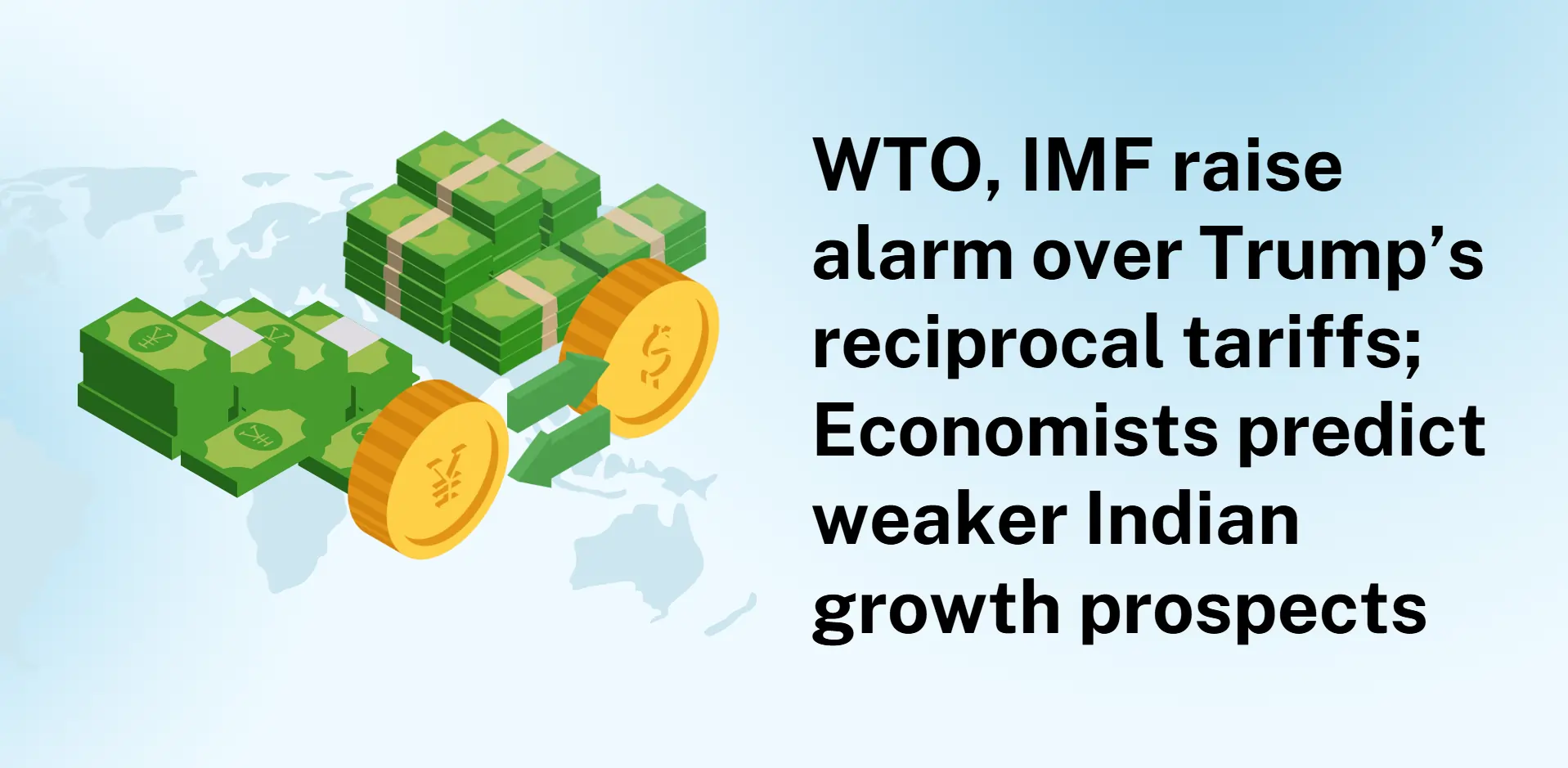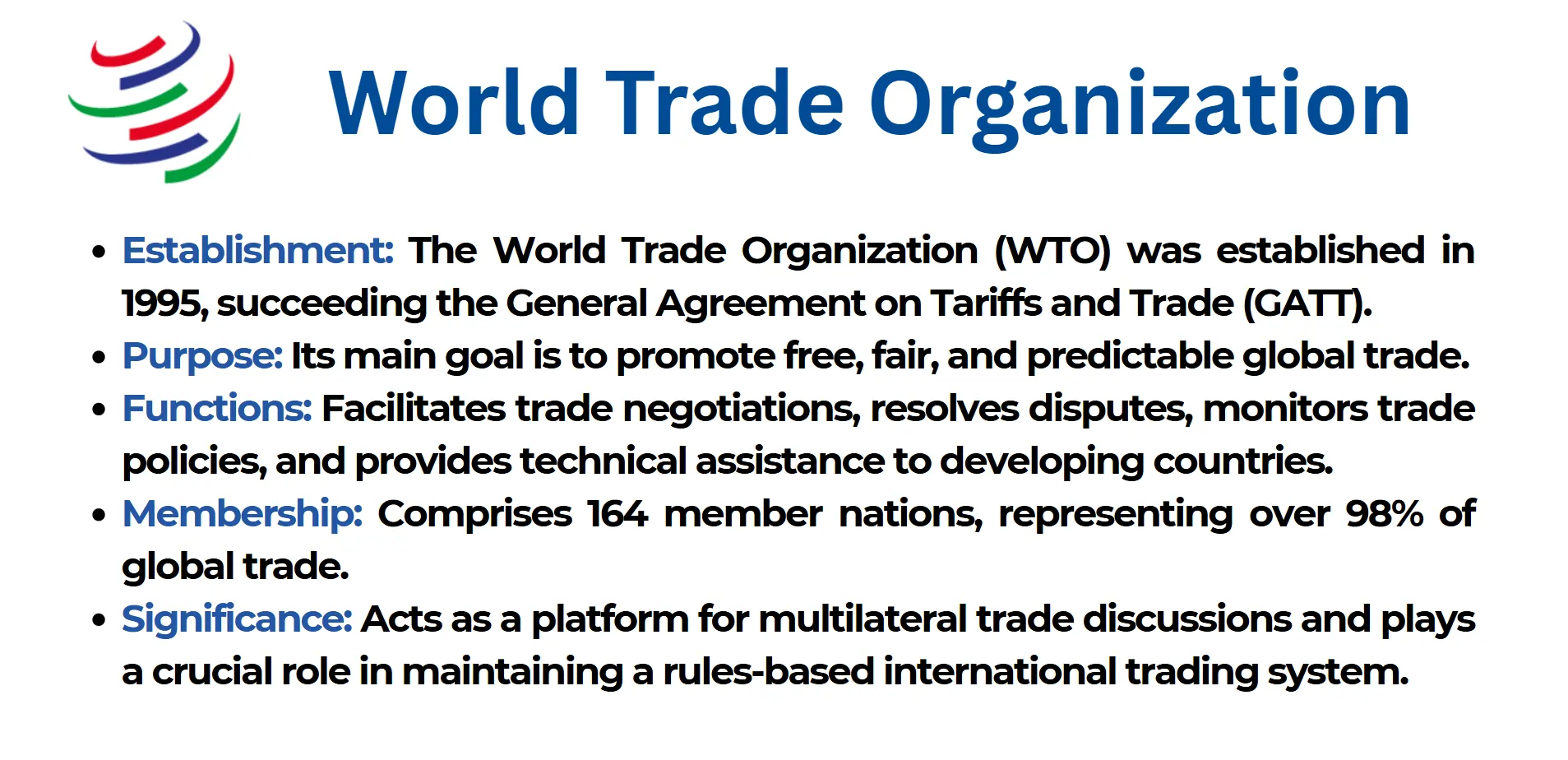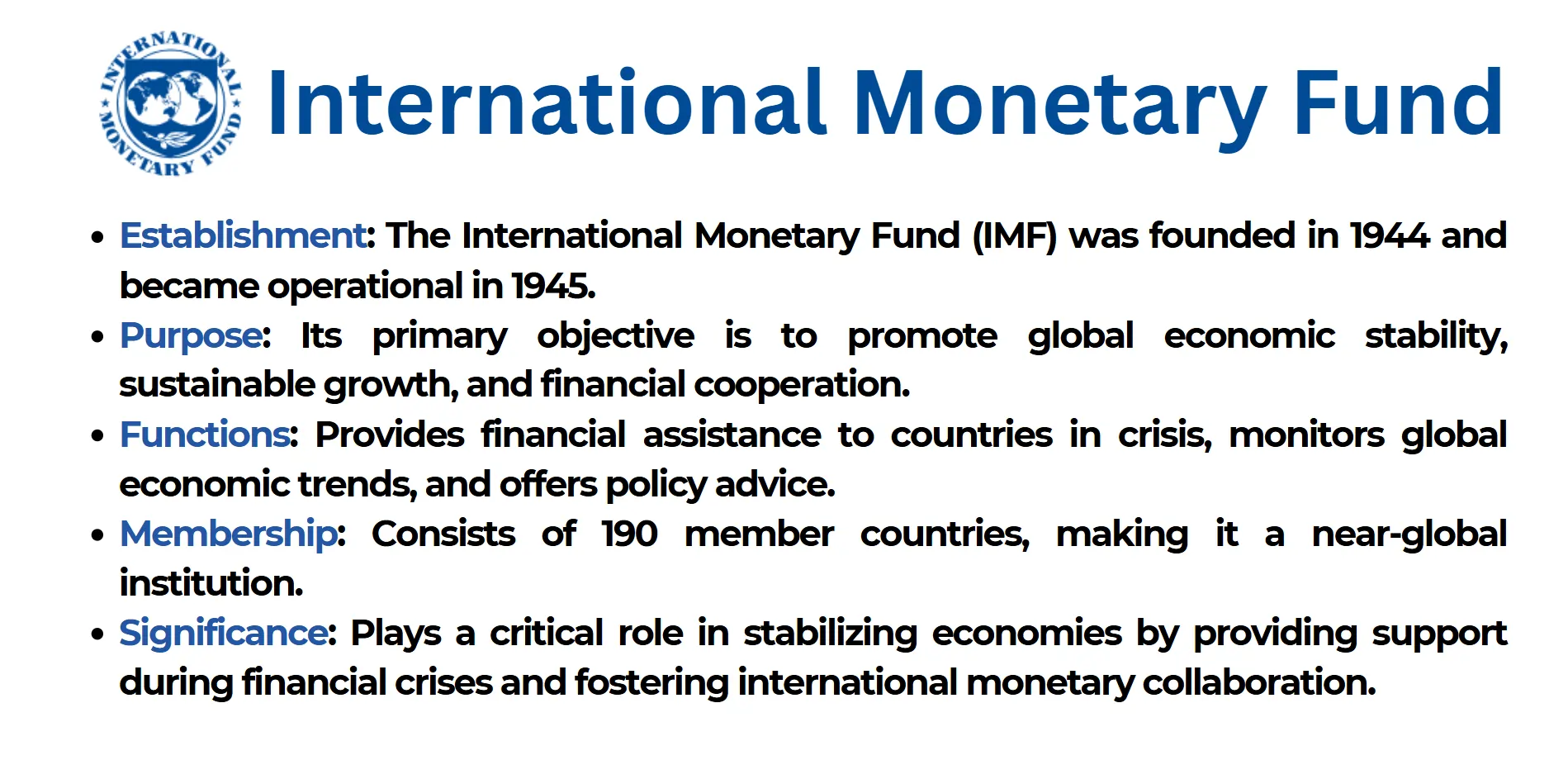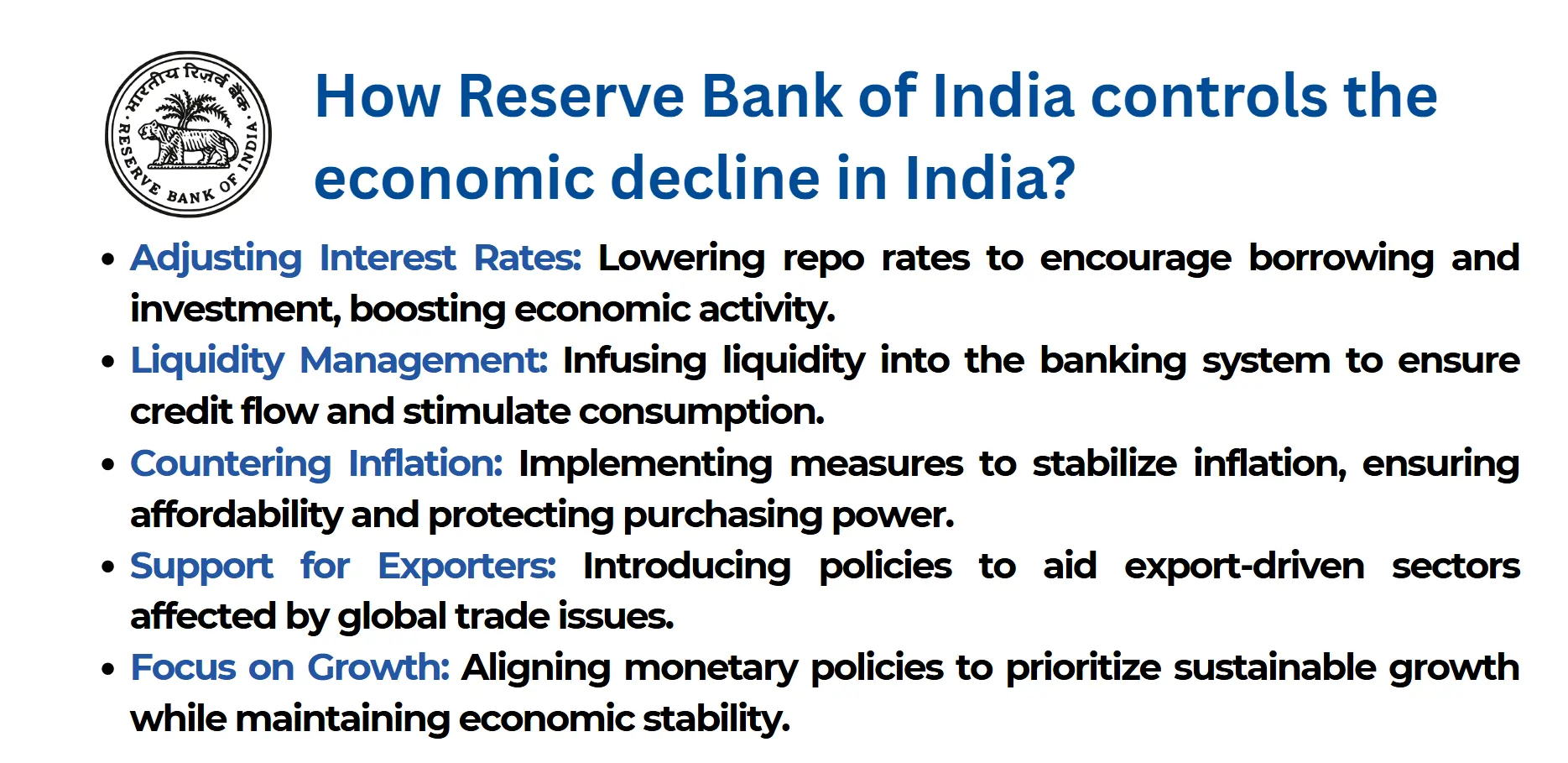According to Goldman Sachs analysis of US final demand influence on India the country faces a projected impact of 30-basis-points on GDP growth during this year.

The worldwide financial organizations including the WTO and IMF view Trump's implementation of trade taxes as a serious worldwide economic concern. The tariffs used against countries regarded for their unfair trade barriers represent the adoption of protectionist measures by the United States. The Protectionist tariffs measures harm the interconnected nature of the modern global economy even though they were established to support home-based industry development. The WTO has predicted decreasing trade volumes but the IMF predicts financial stability disruptions will occur. The expected growth slowdown in India becomes a matter of serious concern due to predictions from economic experts. The economic strength of India faces skepticism because of escalating export tariffs combined with increasing national issues. The article examines various economic effects triggered by these tariffs and evaluates their influence on worldwide commerce and Indian economic expansion as well as possible solutions to address resulting difficulties.
Understanding Reciprocal Tariffs
In modern international trade policies reciprocal tariffs serve as import taxes which countries put into place following the tariffs foreign nations implement against them. Such trade obstacles establish their foundation from fairness principles because they strive to rectify perceived unbalanced international trade arrangements. When one country adopts high trade barriers toward imported goods their trading counterpart responds identically to create equality.
This trade response emerges for two reasons: extended international trade disputes and feelings of unfair treatment experienced by domestic industries. Supporters state that bilateral tariffs create equal business competition and shield home market businesses from anti-competitive behaviour by international competitors. These measures work toward inducing discussions which could create mutual breaks in tariffs toward building an equalized worldwide commercial atmosphere. Such policies demonstrate significant impact on various aspects of implementation.
The United States initiated reciprocal tariffs during Donald Trump's presidency because they served as fundamental elements of America's trade protectionist policies. The targeted countries displayed excessive regulations that restricted U.S. export growth according to American views. This method which aimed to safeguard American industries and decrease trade imbalance encountered negative reactions from World Trade Organization (WTO) and International Monetary Fund (IMF). World officials issued statements that threatened reciprocal tariffs would ignite escalating trade disputes which would destroy supply chains while endangering worldwide economic development.
The implementation of reciprocal tariffs presents various problems for India and other nations. The growth of India depends on exports yet its progress faces further restrictions from key trading markets. Retaliatory tariffs that governments apply frequently begin trade wars between countries that produce adverse effects for global trade.
WTO and IMF’s Concerns
The World Trade Organization (WTO) alongside the International Monetary Fund (IMF) have shown concern about increasing mutual trade barriers which major economies have put into practice. The tariffs raise concerns for these organizations because they threaten to destabilize worldwide trade structures along with economic equilibrium.

The WTO which administers international trade agreements stresses that retaliatory tariffs endanger principles of free and fair trade. When countries initiate restrictions they create a pattern of growing trade limitations that diminish world commercial activities. The reaction produces diminished trade quantities alongside weakened worldwide supply networks which also diminishes business forecasting reliability. The World Trade Organization requires member states to collaborate for conflict resolution without using protective trade measures.
The IMF, meanwhile, highlights the macroeconomic consequences of reciprocal tariffs. The economic measures threaten to decrease worldwide growth and trigger global price rises along with market financial instability across developed nations and developing economies. The IMF identifies global investment movements and consumer assurance rates as the essential areas vulnerable to the spreading effects of trade tariffs. The situation becomes critical for developing nations particularly in India because they need exports and foreign investments for economic development.

The organizations endorse the requirement of diplomatic talks to process trade problems and to decrease unwelcome consequences from protective actions. These institutions insist that independent protectionist measures like reciprocal tariffs weaken the collective systems which help preserve global financial equilibrium. Policymakers must engage in constructive negotiations rather than retaliation according to the WTO and IMF because they understand cooperation protects the fragile global economy. The officials highlight the importance of joining forces to combat economic nationalism since their words emphasize this necessity.
Impact on Global Trade
The worldwide trade has become vulnerable because major economies are implementing reciprocal global trade barriers. The implemented protective measures for domestic industries produce wide-reaching effects which threaten the complex international business relationships.
Global trade operation volumes experience a direct reduction. The imposition of reciprocal tariffs triggers chains of retaliatory measures between nations because countries match tariffs with counter-tariffs. The result of this situation produces market instability which harms supply networks and drives expenses higher. Companies dealing with international trade must bear additional costs that normally transfer to customer prices thus driving up prices while lowering product purchase intent.
Trade cooperation agreements together with multilateral relationships face major risk from rising trade tariff escalations throughout the world. The World Trade Organization (WTO) alongside other organizations takes a hit to their authority when countries opt for unilateral trading approaches despite established international frameworks. Economic stability between countries depends on trust and predictability which these disruptive actions can damage.
The adjustments that arise from changes impact developing nations most severely. The economic development of multiple nations heavily depends on export activities along with job creation. Higher tariff rates reduce their market performance which blocks their entry into major markets and weakens their sales capabilities. Fewer economic resources prevent smaller nations from obtaining desirable trading conditions thus they face worsening economic situations.
International trade uncertainties create fears among investors that adversely affect business stability. Companies hold off their expansion and investment strategies because they worry about changing trade policies which results in slowed economic expansion. The slowing growth of trade and investment creates adverse effects throughout the world economy in developed and developing nations.
The consequences which spread from reciprocal trade barriers demonstrate that saving national interests through such measures leads to serious problems for interlinked financial systems worldwide. Future economic disasters can only be avoided through cooperative dialogue backed by cooperation.
India’s Economic Growth Prospects
The United States under Donald Trump launched a policy of market-for-market tariff exchanges which has created substantial obstacles for India to achieve economic growth. India faces increased export market sensitivity because it stands among the global leaders for economic growth.
The United States constitutes India's primary trading union and thus elevated Indian tariffs on merchandise harm India's export budget. Higher duties reduce the market competitiveness of textile producers and pharmaceutical manufacturers and engineering goods suppliers in the United States. The elevated import taxes produce a negative impact on India’s foreign trade stability and the progress of sectors that create abundant employment possibilities.
Expert economists estimate that the country may lose 30 to 40 basis points from its GDP growth as a result of these trade barriers and will face challenges in achieving its economic goals. The worldwide trade slowdown activated by these trade restrictions intensifies all existing domestic obstacles. Global investors maintain lower confidence because foreign demand for Indian products has declined and international markets have become less predictable.
India deals with two problems simultaneously through rising inflation while continuing to require structural reforms within its borders. The combination of retaliatory measures leads to elevated import expenditures for raw materials which consequently reduce business revenue. Rising market volatility in global sectors would contribute to unstable currency values of the rupee which places financial stress on businesses that depend on imports.
The government must establish trade relations with emerging markets and neighbouring countries as a method to reduce potential challenges during these times. The domestic production capacity can be enhanced by government support for manufacturing activities as well as infrastructure investments to decrease dependency on exports. The strategic resolution of these concerns enables India to adapt its economy to global trade changes along with maintaining economic stability and growth success. The economic stability in challenging times depends heavily on organizations demonstrating cooperation and adaptability to reach this goal.
Policy Responses and Recommendations
The economic issues stemming from reciprocal trade barriers require policymakers to implement suitable responses which handle direct customs barriers and overall market distortions. Economic stability requires government institutions to develop measures that protect trade initiatives alongside financial security objectives.
The Reserve Bank of India through financial policy modifications has the potential to prevent economic decline in India. The lowering of interest rates by monetary policy will support investment growth and consumer spending which provides businesses protection from trade disruptions caused by new tariffs. The economic environment needs strategic tax policies that motivate export-oriented businesses to combat industries which face negative impacts from elevated tariffs.

The first important move needs to be improving negotiations between two countries regarding trade. India should put diplomatic efforts first toward the United States and essential trading partners to build agreements while working to decrease trade obstacles between countries. The expansion of trade connections between India and emerging economies together with regional business partners will help reduce Indian trade dependence on established export markets.
As a global organization the World Trade Organization (WTO) enables nations dealing with tariff conflicts to establish constructive negotiations. The adherence to international trade rules combined with dispute settlement solutions prevents trade disagreements from growing more intense. Through international dialogues India alongside other smaller economies manages to preserve the proper representation of their interests.
The government needs to establish long-term economic measures that will boost India's ability to resist economic threats. The country needs structural reforms that enhance its manufacturing competitiveness and strengthen infrastructure and reduce bureaucratic barriers to adapt to evolving trade systems. The implementation of investments in technology along with innovative measures will make domestic manufacturing sectors more immune to external market threats.
Creation of a proactive system collaborating with others represents the essential solution. National authorities should accomplish two priorities: maintaining steady worldwide trade relations and developing home economic progress. Both immediate actions and strategic long-term strategies enable India together with fellow nations to manage protectionism successfully.
Broader Implications for India
The United States' decision to impose reciprocal tariffs creates widespread implications which negatively affect India's economic situation and disrupts its trade policies and obstructs legislative targets for the long term. The adoption of trade limitations by the United States creates severe challenges for Indian exports in worldwide markets since it brings abrupt difficulties along with future consequences.
The affected markets now show diminished demand for Indian exported goods. The implementation of higher tariffs elevates the market prices of Indian goods thereby decreasing their purchasing appeal to overseas customers. The rising export costs affect labor-intensive export sectors which include textiles along with leather and agriculture so their revenues face reduced growth. The extensive labor force in affected sectors becomes at risk of unemployment because of these trade barriers.
The problems faced in international trade blocks India's pathway toward lasting economic expansion. Expert economic analysis shows that India’s GDP growthv rate will decrease because trade restrictions will reduce exporting activities.
Worldwide trade patterns change dangerously when countries implement counter-tariff strategies which produce harmful market stability effects. Economic problems are likely to arise from rapid changes in the exchange rate as well as unpredictable foreign capital movements in India. The officers responsible for policy design need to preserve macroeconomic equilibrium through special monetary and fiscal policy implementations.
The entire trade alliance framework of India requires strategic reconstruction to meet changing global trade conditions. Economic growth through emerging country relationships and regional alliances allows India to decrease its reliance on primary markets. India should reinforce its operational resilience through overseas trade expansion combined with enhancing the strength of non-sensitive economic sectors.
This time of crisis enables India to establish domestic reforms which will boost its industrial competitiveness while developing protective economic measures for future use. The integrated approach with business diversity and international partnership growth enables India to transform adversity into development purposes which drive transformative economic growth.
Conclusion
Global cooperation proves essential to handle international trade conflicts that emerged from Trump's retaliatory tariffs. The warnings from WTO and IMF serve as a stark reminder of the fragile balance in international commerce. India must introduce strategic transformations and adopt diversification plans and resilience-building components for successful management of its trade-related demands. Despite their immediate disruption of growth these protective measures develop lasting business strength when organizations maintain dialogues and acquire new abilities. National economic prosperity and worldwide economic security need policy authorities to make decisions rapidly for continuing protection.